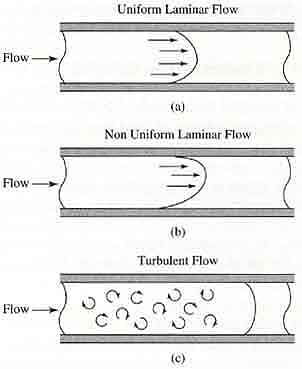AMAZON multi-meters discounts AMAZON oscilloscope discounts
It is important to understand the terms relating to flow before you can fully understand flow sensors. Fluid is the term that describes any substance that flows. Liquids such as water or hydraulic fluid and gases such as oxygen or nitrogen are all considered fluids since they flow. The terms liquid and gases describe two of the three states (solid, liquid, gas) of any substance. The flow rate of a fluid as it flows through a pipe can be calculated by the formula
Q = V X A
where
Q = liquid flow through a pipe
V = average velocity of the flow
A = cross-sectional area of the pipe
It's important to understand this formula is a basic relationship for flow and does not take into account the density or viscosity of the fluid or the friction in the walls of the pipe.
Exercise 1:
Determine the flow of hydraulic fluid through a 2 in. diameter pipe that has an average velocity of 60 in. per second.
SOLUTION:
1. First you must find the cross-sectional area of the pipe by the formula:
A = Πr2
A = 3.14 X (1 in.)'
A = 3.14 sq in.
2. Use the formula Q = V X A to find flow:
Q = 60 psi x 3.14 in.2
Q = 118.4 cu in./sec
Other terms that are important to understand are laminar flow and turbulent flow. The image below provides three diagrams that show uniform laminar flow, non-uniform laminar flow, and turbulent flow. Laminar flow means that the fluid flows parallel to the pipe and the flow is rather smooth. Turbulent flow is characterized by swirling action of the fluid inside the flow. Image (a) below shows a diagram of uniform laminar flow. From this diagram you can see that the flow is very uniform and has the shape of a bullet, which indicates that the flow is streamline. Image (b) shows a diagram of non-uniform laminar flow. This diagram shows the overall shape of the flow is parallel, which indicates it's laminar, but the front nose of the flow is parabolic, which means the fluid has more friction on one side of the pipe than the other. Image (c) show an example of turbulent flow. From this diagram you can see that the fluid is swirling as it flows. The swirling action tends to create opposition to the flow.

Another important term pertaining to fluid flow is the Reynolds number. The Reynolds number is the ratio of a fluid's inertial forces to its drag forces. The flow rate and the specific gravity of a liquid are part of its inertial forces, and the pipe diameter and viscosity of the fluid make up its drag forces. The Reynolds number is dimensionless, but it can be calculated by the following formula:

where
R = Reynolds number
G, = specific gravity of the liquid
Q = flow rate for the liquid in gallons per minute (gpm)
D = the inside diameter of the pipe in inches
µ= viscosity of the liquid in ft/sec
Exercise 2:
Determine the Reynolds number for a liquid flowing through a pipe with an inside diameter of 2 inches, whose specific gravity is 0.713, its flow rate os 0.2 gps (12 gpm), and its viscosity is 1.17ft2/sec
SOLUTION:
Use the formula (be sure to convert diameter to feet):
R = (3160 x Q x Gt) / (D x μ)
R = (3160 x 0.2 gps x 0.713) / (0.16 ft x 1.17 ft2/sec)
R = 2409.7